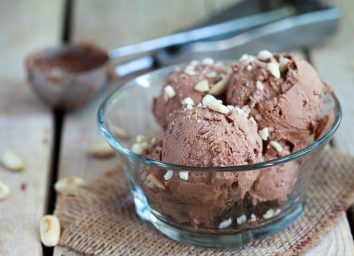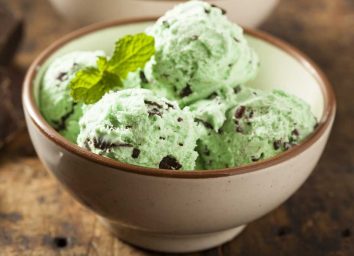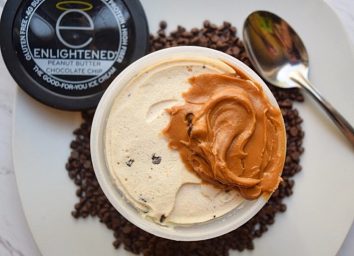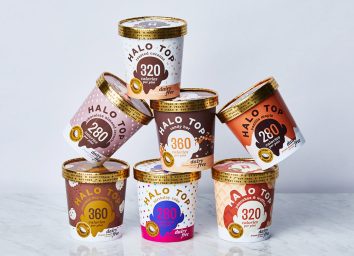15 Unhealthiest Ice Cream Pints on Grocery Shelves
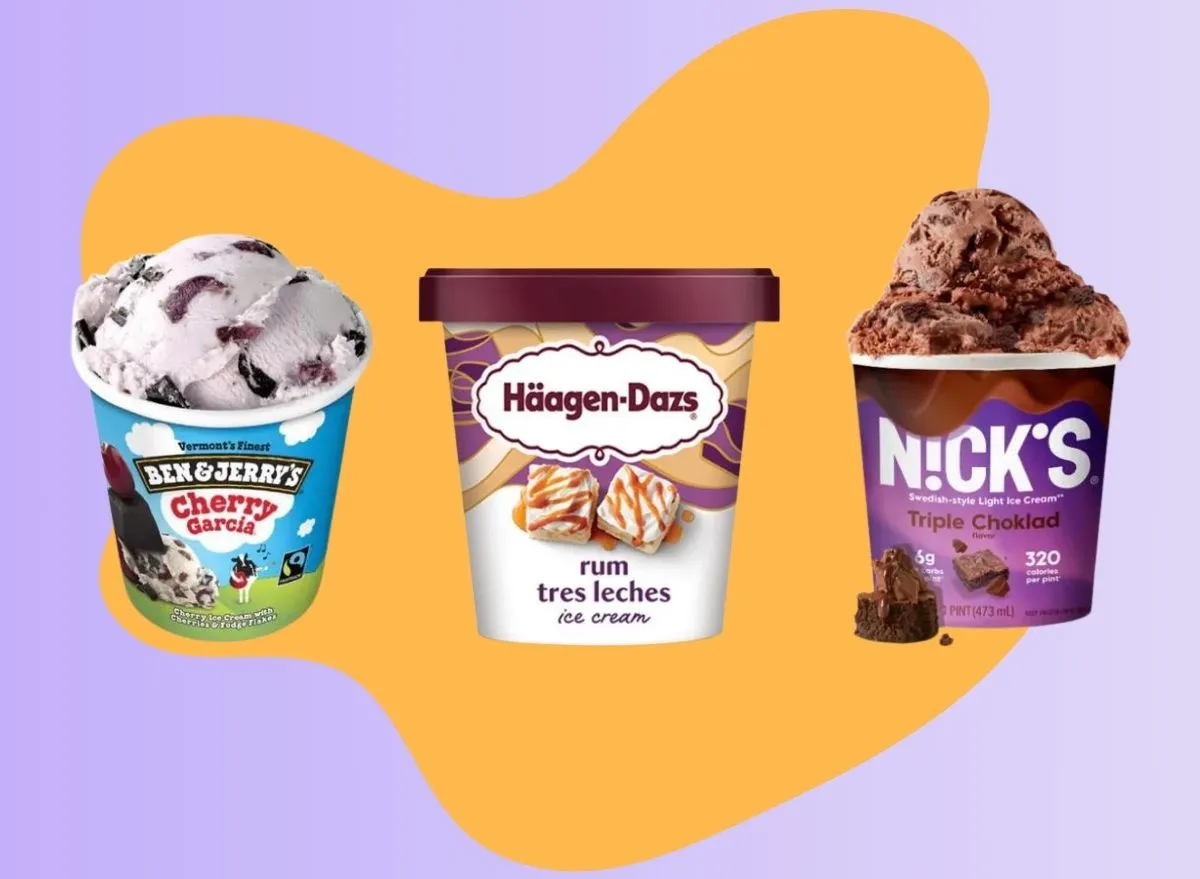
Whether in the heat of summer or the frost of winter, ice cream is the perfect treat. There’s an ever-growing array of different flavors and brands to choose from, with something out there for every palate and mood. Need a refreshing flavor to cool down? Try strawberry or lime. Looking for something rich and indulgent? Perhaps an espresso or salted caramel can set the tone. With so many options in the freezer aisle, you’re bound to find an ice cream that suits your taste.
Many artisan and mainstream ice cream companies alike have begun offering pint sizes (versus larger tubs or single-serving cups) that are available at your local grocery store. Pints are perfect for sharing (or not!) and enable ice cream enthusiasts to pick up multiple flavors to sample at home. However, as with every sweet treat on the market, some brands fall short in terms of nutrition and quality. Certain companies even harp on the health benefits of their ice cream or the quality of their ingredients when, in reality, their fat, calorie, and sugar contents are through the roof.
Of course, no one ever claimed to eat ice cream for its health benefits. After all, it’s a dessert! Ice cream should be eaten for fun and, ultimately, in moderation. But there are certainly some unhealthy ice creams that are worse than others when it comes to nutrition. To help you navigate the ice cream aisle on your next shopping trip, we’ve rounded up 15 of the absolute unhealthiest ice cream pints, so you can stick to the good stuff and enjoy all the nostalgic tastes that this sweet treat has to offer.
How We Chose the Unhealthiest Ice Creams:
- Over 200 Milligrams of Sodium: Although it may not be top-of-mind, ice cream can contain high levels of sodium. Sodium isn’t just used to make things taste salty; it’s also used to enhance flavor (have you ever had salt on your watermelon?) and even preserve perishable products. In our opinion, a pint of ice cream shouldn’t contain more than 200 milligrams of sodium because, at its core, ice cream should be a dairy-based product without the unnecessary addictive additions found in many mainstream brands. It’s important to be vigilant with sodium intake as the American Heart Association recommends no more than 2,300 milligrams of sodium per day (with a goal of 1,500 milligrams) as excess sodium intake can lead to a slew of health risks such as cardiovascular disease, high blood pressure (hypertension), and even adverse effects on essential organs such as the kidney.
- Artificially Flavored, Sweetened, and/or Colored: At its baseline, there may not be anything ‘wrong’ with artificial ingredients. All artificial ingredients found in the following ice creams have been approved by the FDA, and when eaten in moderation, these additives may not cause any health issues or adverse side effects. On this subject, scientists and dietitians alike are split, and evidence tends to compete with itself regarding certain ingredients. For example, the FDA does give the green light to certain artificial sweeteners, such as aspartame, despite the fact that agencies like the IARC/WHO deem aspartame a carcinogen. The issue is that this is such a gray area that we simply aren’t comfortable recommending indulging heavily in ice creams that are chock full of artificial ingredients, especially when so many better-for-you brands are producing higher-quality products that taste just the same (or better). Of course, always defer to your healthcare provider to determine whether artificial ingredients are OK for your own needs.
- Over 10 Grams of Saturated Fat: Of course, ice cream has saturated fat—that’s a given. Saturated fats are also known as ‘solid fats’ as they solidify at room temperature. Most saturated fats, besides oils and meats, are dairy products: cream, butter, cheese, ice cream, and so on. Although there is growing debate over the dangers of excess saturated fat, health organizations such as the AHA and the WHO recommend limiting your daily saturated fat consumption for a healthy lifestyle. Of course, there’s a big difference between drinking a glass of reduced-fat milk and eating two big scoops of sugar-packed ice cream, so use your best judgment when considering your saturated fat intake. We’ve decided to go ahead and label any ice cream over 10 grams of saturated fat per pint to be unhealthy so that you can make an easy, snap decision.
So, now that we’ve established the criteria we’re using for unhealthy ice creams, read on to see which 15 flavors you may want to avoid—particularly if you eat the whole pint or more than one serving at a time—and next, check out the 14 Best & Worst Low-Calorie Ice Creams, According to a Dietitian.
Ben & Jerry’s: Chubby Hubby
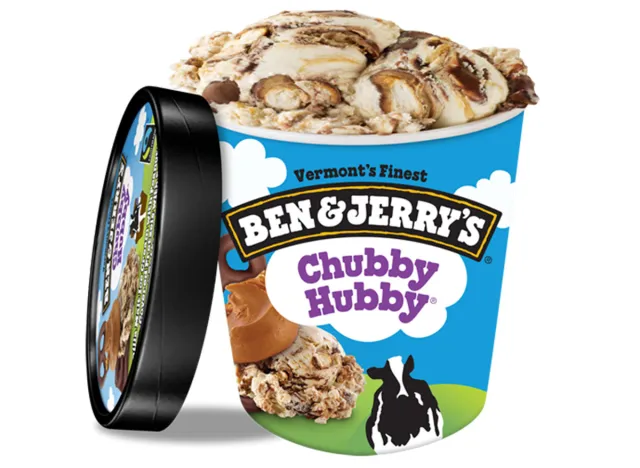
Calories: 1,400
Fat: 85 g (Saturated Fat: 47 g)
Sodium: 880 mg
Carbs: 133 g (Fiber: 7 g, Sugar: 106 g)
Protein: 28 g
Despite its endearing name, Ben & Jerry’s’ Chubby Hubby is (perhaps unsurprisingly) one of the unhealthiest pint flavors in the entire Ben & Jerry’s line. At 1,400 calories per pint, overindulging in this sweet treat puts you at around 70% of your daily caloric needs, averaging out to about 2,000 calories for the average, healthy adult, according to the FDA. This isn’t to mention the whopping 82 grams of added sugar, 47 grams of saturated fat, and even 880 milligrams of sodium within this one small pint. In our opinion, take Chubby Hubby at face value and avoid it.
Häagen-Dazs: Rum Tres Leches Ice Cream
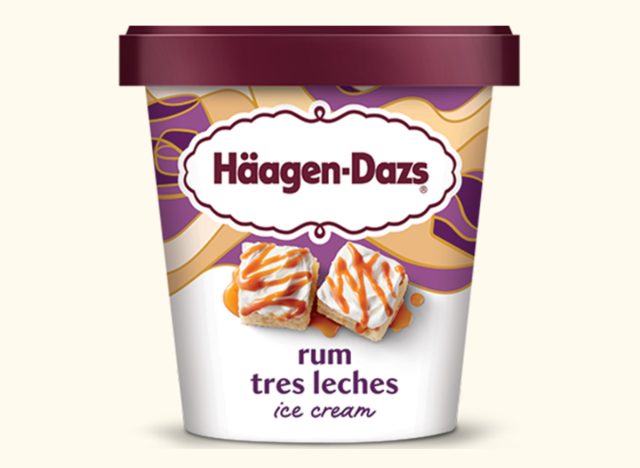
Calories: 900
Fat: 52 g (Saturated Fat: 33 g)
Sodium: 250 mg
Carbs: 86 g (Fiber: 0 g, Sugar: 69 g)
Protein: 13 g
Unfortunately, Häagen-Dazs’ Rum Tres Leches Ice Cream more than earns a place on our list of unhealthiest ice cream pints. At 900 calories per pint—the higher end of the Häagen-Dazs caloric spectrum—and with no fiber to be found, this ice cream should be given a wide berth. We want to point out that this pint also uses palm oil, which, although not necessarily unhealthy, does directly contribute to rainforest deforestation if not certified by certain NGOs such as WWF, which rates brands using the Palm Oil Buyers Scorecard. Häagen-Dazs has yet to even be evaluated.
Ben & Jerry’s: Phish Food
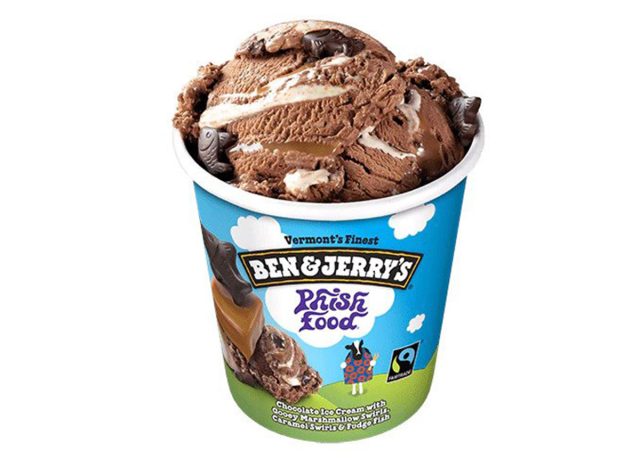
Calories: 1,170
Fat: 55 g (Saturated Fat: 39 g)
Sodium: 320 mg
Carbs: 155 g (Fiber: 6 g, Sugar: 112 g)
Protein: 16 g
Although a Ben & Jerry’s classic, Phish Food contains—wait for it—a whopping 102 grams of added sugar per pint. With marshmallow swirls, fudge fish, and caramel swirls, you certainly don’t open the lid thinking that you’re about to indulge in something nutrient-dense. However, 102 grams is a positively egregious amount of added sugar, even for ice cream. The American Heart Association recommends that the average, healthy woman should receive no more than 6% of her daily calories from added sugars—about 100 calories per day, or 150 for healthy adult men. A pint of this ice cream provides 204% of your daily added sugar limit.
Blue Bunny: Twist Pints Blu’s Birthday Cake
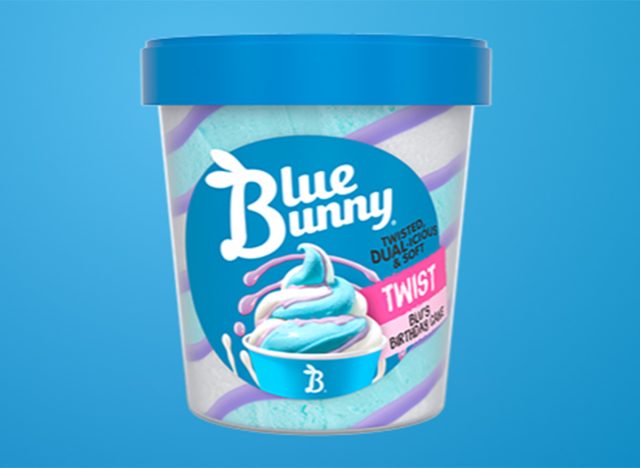
Calories: 630
Fat: 23 g (Saturated Fat: 18 g)
Sodium: 220 mg
Carbs: 97 g (Fiber: <1 g, Sugar: 86 g)
Protein: 7 g
Although Blue Bunny’s Twist Pints Blu’s Birthday Cake doesn’t have the dense caloric makeup of other brands on this list, this pint has earned a spot as one of the unhealthiest due to its dubious ingredients. Although many better-for-you brands have harnessed the power of plants like spirulina to create that blue tinge, Blue Bunny still sticks with artificial colorings, including Red 40, which may exacerbate symptoms of hyperactivity and ADHD in certain children. Additionally, this ice cream includes ‘artificial flavors’ that, unfortunately, remain vague and untraceable.
N!ck’s: Peanöt Karamell Krunch
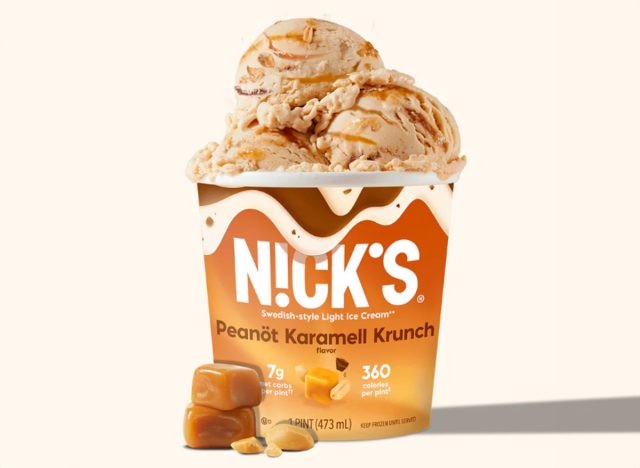
Calories: 320
Fat: 24 g (Saturated Fat: 13 g)
Sodium: 640 mg
Carbs: 65 g (Fiber: 25 g, Sugar: 3 g)
Protein: 17 g
It seems to be a growing trend that certain ‘health food’ companies market their products as low-sugar or low-fat, but what they don’t mention is that they often include higher sodium levels to make up for lost taste. N!ck’s Swedish-style ‘light’ ice cream is no exception. A pint of their Peanöt Karamell Krunch ice cream contains a whopping 640 milligrams of sodium, which is higher than the majority of other ice creams on our list. The AHA recommends no more than 2,300 milligrams of sodium per day for the average, healthy adult, with the preferred goal of no more than 1,500 milligrams. So, if you do indulge in this one, make sure you’re watching your sodium for the rest of the day.
Blue Bell Ice Cream: I Heart Cereal
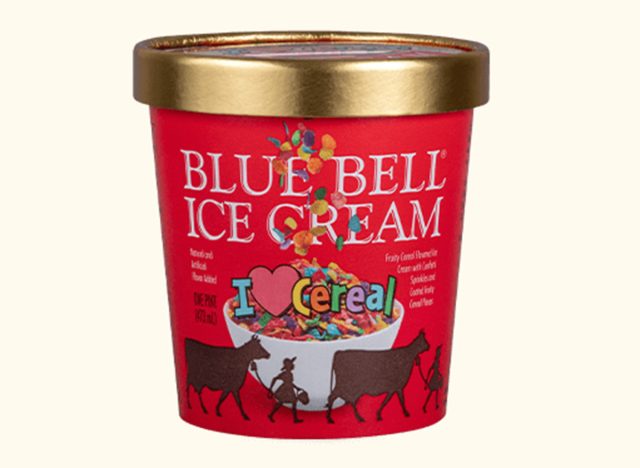
Calories: 720
Fat: 39 g (Saturated Fat: 26 g)
Sodium: 200 mg
Carbs: 82 g (Fiber: 0 g, Sugar: 77 g)
Protein: 13 g
Yes, artificially fruity and sugar-coated cereal is delicious, but at what nutritional cost? Blue Bell’s I Heart Cereal is a combination of fake-fruity flavors, confetti sprinkles, and cereal pieces that amount to an amalgamation of artificial dyes and flavors, stabilizers, and palm oil to create something that, at its core, really isn’t ice cream at all. Although we don’t want to fearmonger when it comes to artificial ingredients, there’s really no need for it in ice cream as we have seen scores of other brands strip ice cream down to its natural basics for a richer, more flavorful taste experience.
Halo Top: Sea Salt Caramel
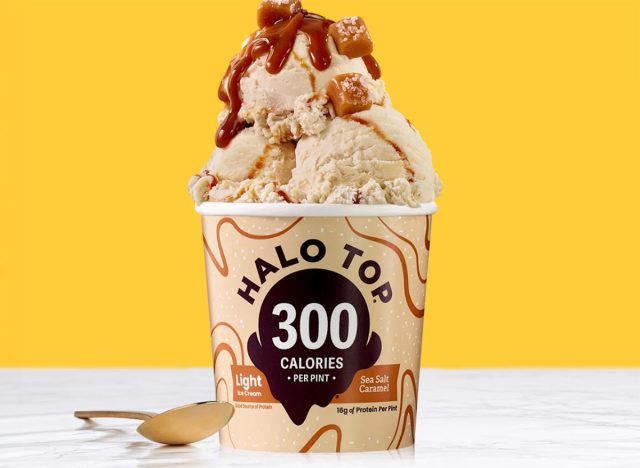
Calories: 300
Fat: 5 g (Saturated Fat: 3.5 g)
Sodium: 450 mg
Carbs: 68 g (Fiber: 18 g, Sugar: 29 g)
Protein: 16 g
Although Halo Top boasts only 300 calories and 3.5 grams of saturated fat per pint of Sea Salt Caramel, let’s take a deeper look into how these nutritionals are even possible. This ice cream contains more than a few dubious ingredients that really don’t have a place in ice cream. Take xanthan gum, for example, which has been linked to an increased risk of type-2 diabetes based on observational data, raising the eyebrows of some healthcare providers (don’t freak out about this ingredient, though; we need more data to truly deem it unsafe). This ice cream also contains erythritol, an artificial sweetener that is linked to cardiovascular events such as heart attacks. Remember, low calories don’t necessarily make something a healthier choice.
Mayfield Creamery: Strawberry
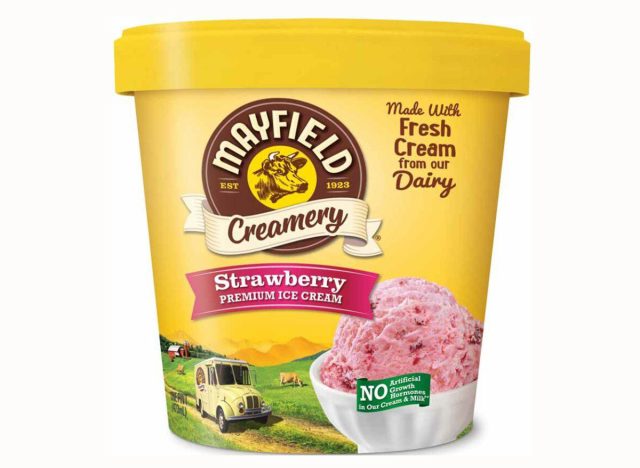
Calories: 510
Fat: 24 g (Saturated Fat: 15 g)
Sodium: 150 mg
Carbs: 72 g (Fiber: 0 g, Sugar: 60 g)
Protein: 6 g
Mayfield Creamery’s Strawberry ice cream is another example of how ‘unhealthy’ can be a hidden determinant. We’re not big fans of Mayfield’s strawberry ice cream as it’s artificially colored with Red 40, although it does include annatto extract and strawberry puree, both of which are natural sources of that classic pink coloring. We’re not sure why Mayfield included Red 40 in their mixture. Remember, this artificial dye can lead to hyperactivity in children, but it may also lead to more severe health consequences, including inflammation of the colon and changes in the gut microbiome (although further studies are needed to corroborate these claims).
Ben & Jerry’s: The Tonight Dough
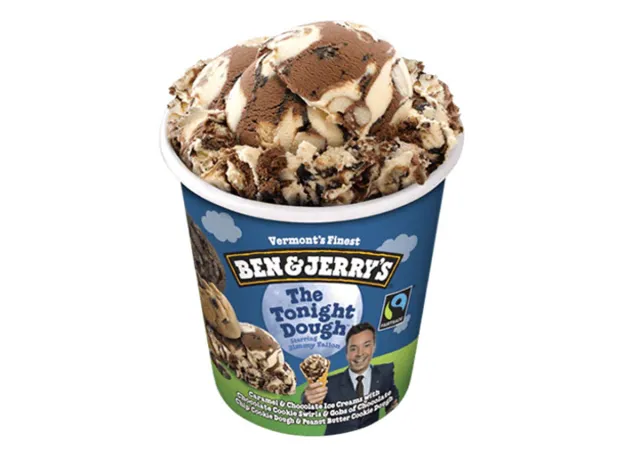
Calories: 1,220
Fat: 66 g (Saturated Fat: 32 g)
Sodium: 440 mg
Carbs: 142 g (Fiber: 5 g, Sugar: 108 g)
Protein: 18 g
As loveable as Jimmy Fallon is, we’re not too enthusiastic about Ben & Jerry’s The Tonight Dough flavor. This ice cream is far from healthy as it contains over half your daily calorie needs and a whopping 92 grams of added sugar. Overindulgence in added sugars doesn’t just lead to obvious health problems such as obesity, but it can also exacerbate severe health outcomes, including inflammatory diseases such as rheumatoid arthritis, psoriasis, and inflammatory bowel disease, to name a few. Ben & Jerry’s really needs to get its act together—and don’t be fooled by its dairy-free alternative, which is just as unhealthy.
N!ck’s: Triple Choklad
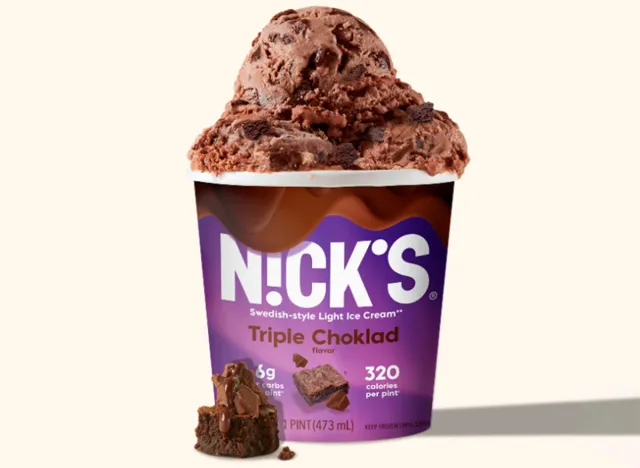
Calories: 320
Fat: 20 g (Saturated Fat: 13 g)
Sodium: 450 mg
Carbs: 70 g (Fiber: 25 g, Sugar: 2 g)
Protein: 13 g
N!ck’s Ice Cream is known for its ‘light’ ice creams, but what allows its Triple Choklad ice cream to have 0 grams of added sugar and only 320 calories yet still remain delicious? The answer is sorbitol, a sugar alcohol often found in foods like sugar-free gums. A pint of this ice cream contains 18 grams of this sugar alcohol. Unfortunately, sorbitol may seem like a good option, especially for those managing diabetes, but this artificial sweetener has been linked to gastrointestinal issues such as chronic diarrhea and bloating. So, you may not have the most comfortable experience after eating this ice cream, and you’re still ingesting 100% of your daily saturated fat limit.
Blue Bell Ice Cream: Java Jolt
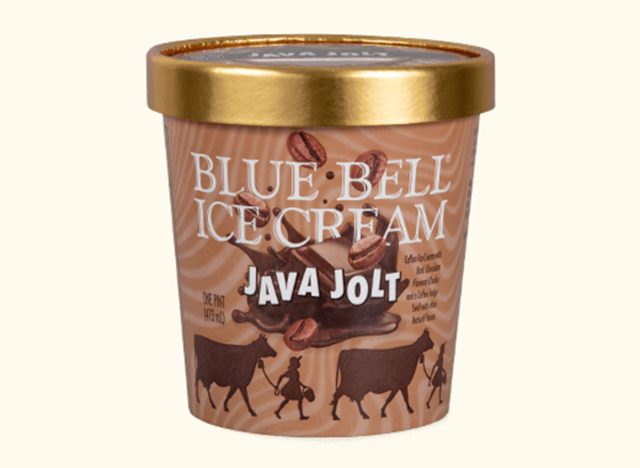
Calories: 790
Fat: 45 g (Saturated Fat: 26 g)
Sodium: 240 mg
Carbs: 98 g (Fiber: 4 g, Sugar: 86 g)
Protein: 14 g
With shockingly high added sugar counts, 26 grams of saturated fat, and nearly 40% of your daily calorie needs, Blue Bell Ice Cream’s Java Jolt is doing you no favors. Coffee doesn’t come in until far down the ingredient list, so in our opinion, it’s much healthier to simply drink a cup of coffee to get your fill instead of indulging in this sugar-filled concoction. Additionally, your cup of Joe probably won’t have as many low-quality ingredients that don’t seem to have their place in ice cream when so many other brands are going without.
Häagen-Dazs: White Chocolate Raspberry Truffle
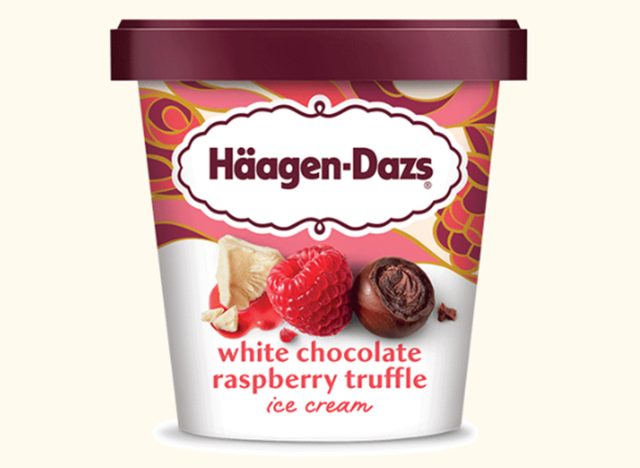
Calories: 960
Fat: 53 g (Saturated fat: 33 g)
Sodium: 220 mg
Carbs: 107 g (Fiber: 2 g, Sugar: 97 g)
Protein: 13 g
Häagen-Dazs’ White Chocolate Raspberry Truffle ice cream may provide 20% of your daily calcium needs, but how about we recommend that you just drink a glass of reduced-fat milk with a cup of raspberries instead? One pint of this ice cream provides almost half of your daily calorie needs while containing nearly three times the daily recommended amount of saturated fat. Remember, overindulgence in saturated fats may lead to higher risks of cardiovascular disease, and studies show a suggested correlation between reduced saturated fat consumption and reduced cardiovascular disease risk.
Halo Top: Keto Peanut Butter Chocolate
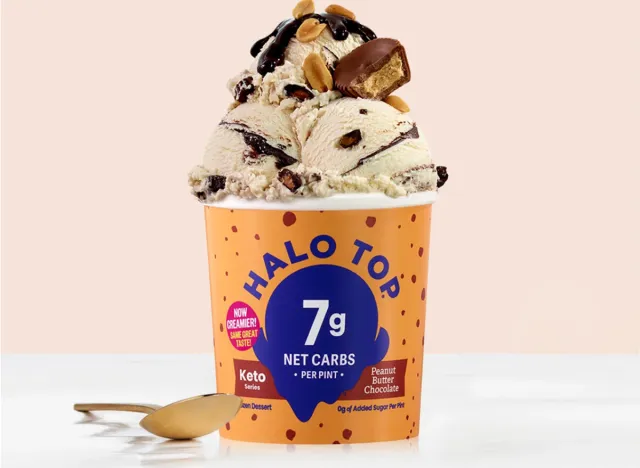
Calories: 630
Fat: 59 g (Saturated Fat: 30 g)
Sodium: 470 mg
Carbs: 45 g (Fiber: 15 g, Sugar: 5 g)
Protein: 6 g
We’ll say it once, and we’ll say it again: just because something is labeled ‘keto’ doesn’t make it healthy. Ketosis can aid in metabolism improvement and inflammation markers, but that doesn’t mean you need to fuel your body with unnecessary fats in the process. Halo Top’s Keto Peanut Butter Chocolate contains egregious amounts of saturated fats at over 2.5x the daily limit as recommended by the AHA. The American Heart Association recommends that the average healthy adult should consume no more than 13 grams of saturated fat per day, which comes out to about 120 calories derived from saturated fats. Therefore, one pint of this keto ice cream contains 150% of your daily saturated fat limit.
Ben & Jerry’s: Cherry Garcia
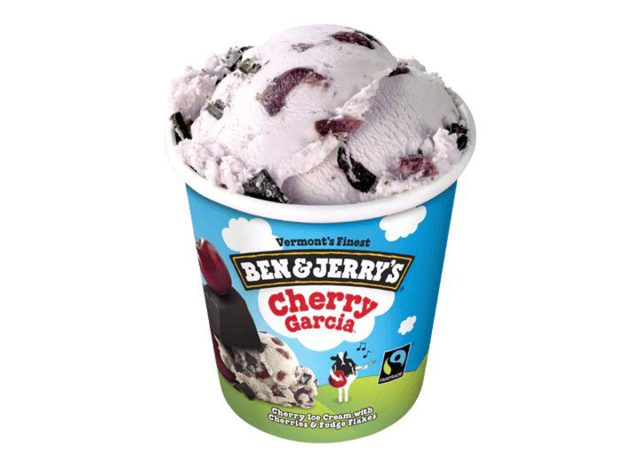
Calories: 1,030
Fat: 59 g (Saturated Fat: 40 g)
Sodium: 180 mg
Carbs: 114 g (Fiber: 2 g, Sugar: 110 g)
Protein: 15 g
It’s hard to look past those 110 grams of sugar—92 grams of which are added—but what’s most concerning is actually a nutrient count that’s not often noticed on many labels. One pint of Ben & Jerry’s’ Cherry Garcia ice cream contains 235 milligrams of cholesterol, or 78% of your daily value, according to the FDA’s guidelines. Although there is good cholesterol, we can go ahead and say that you’re not deriving many good fats from this ice cream. Too much ‘bad’ cholesterol has been linked to serious health risks such as atherosclerosis, the formal name for plaque buildup in your arteries. This can lead to a slew of coronary and kidney issues, and really, it should be discussed more widely. In other words, this is one unhealthy ice cream pint.
Ben & Jerry’s: Everything But The…
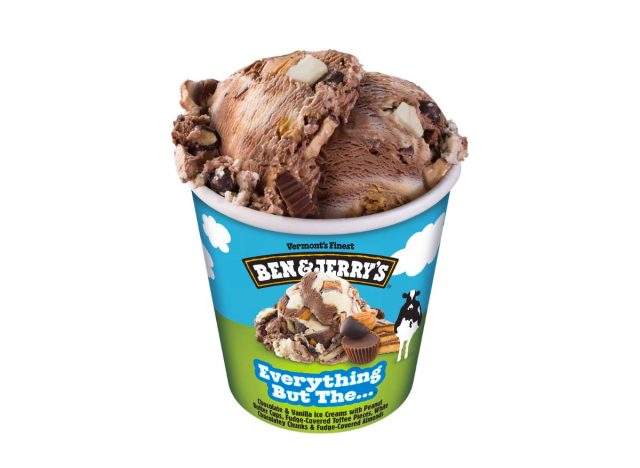
Calories: 1,250
Fat: 78 g (Saturated Fat: 52 g)
Sodium: 320 mg
Carbs: 121 g (Fiber: 5 g, Sugar: 114 g)
Protein: 20 g
We know, we’ve given Ben & Jerry’s ice cream quite a lot of grief, but it’s not without reason: their ice creams contain some of the highest calorie, fat, and sugar counts that we’ve ever seen. Perhaps one of the unhealthiest flavors is their Everything But The… which probably comes as no surprise. This ice cream contains both chocolate and vanilla ice cream, peanut butter cups, fudge-covered toffee pieces, white chocolate chunks, fudge-covered almonds…and 92 grams of added sugar. If you do decide to indulge, we suggest sharing—eating it all at once won’t heighten the flavor.
- Source: https://pubmed.ncbi.nlm.nih.gov/35058650/
- Source: https://www.fda.gov/food/food-additives-petitions/aspartame-and-other-sweeteners-food
- Source: https://www.who.int/news/item/14-07-2023-aspartame-hazard-and-risk-assessment-results-released
- Source: https://pubmed.ncbi.nlm.nih.gov/32562735/
- Source: https://www.heart.org/en/healthy-living/healthy-eating/eat-smart/fats/saturated-fats
- Source: https://www.heart.org/en/healthy-living/healthy-eating/eat-smart/fats/saturated-fats
- Source: https://www.heart.org/en/healthy-living/healthy-eating/eat-smart/sugar/added-sugars
- Source: https://www.jaacap.org/article/S0890-8567(11)00953-1/abstract
- Source: https://www.heart.org/en/healthy-living/healthy-eating/eat-smart/sodium/how-much-sodium-should-i-eat-per-day
- Source: https://pubmed.ncbi.nlm.nih.gov/8329363/
- Source: https://pubmed.ncbi.nlm.nih.gov/36849732/
- Source: https://www.ncbi.nlm.nih.gov/pmc/articles/PMC10502305/
- Source: https://www.ncbi.nlm.nih.gov/pmc/articles/PMC9471313/
- Source: https://www.ncbi.nlm.nih.gov/pmc/articles/PMC6693595/
- Source: https://pubmed.ncbi.nlm.nih.gov/26068959/
- Source: https://www.ncbi.nlm.nih.gov/pmc/articles/PMC6472268/
- Source: https://www.heart.org/en/healthy-living/healthy-eating/eat-smart/fats/saturated-fats
- Source: https://www.heart.org/en/health-topics/cholesterol/about-cholesterol/atherosclerosis

